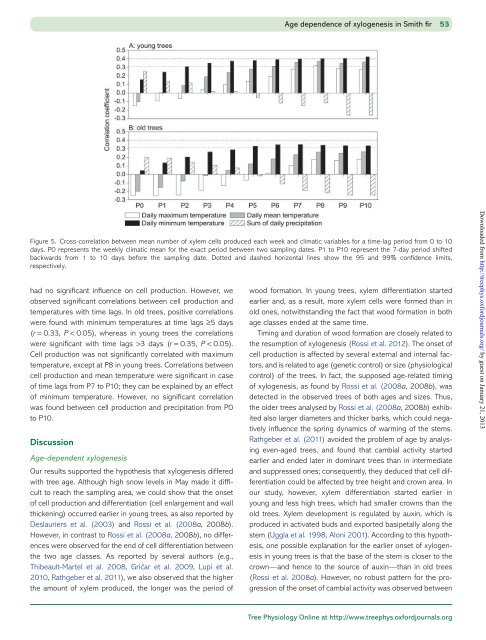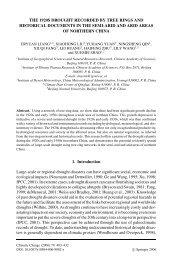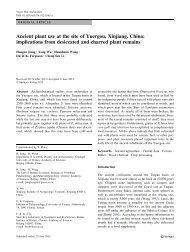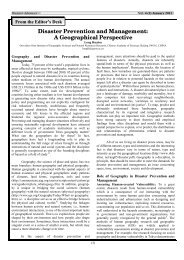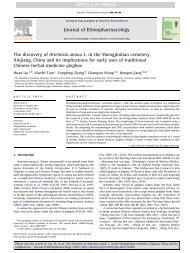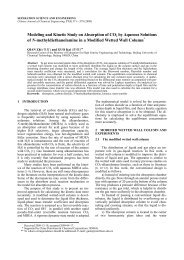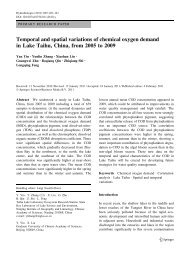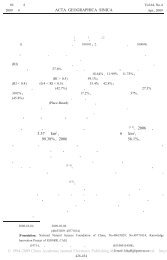AN INTERNATIONAL BOTANICAL JOURNAL
AN INTERNATIONAL BOTANICAL JOURNAL
AN INTERNATIONAL BOTANICAL JOURNAL
Create successful ePaper yourself
Turn your PDF publications into a flip-book with our unique Google optimized e-Paper software.
Age dependence of xylogenesis in Smith fir 53<br />
Figure 5. Cross-correlation between mean number of xylem cells produced each week and climatic variables for a time-lag period from 0 to 10<br />
days. P0 represents the weekly climatic mean for the exact period between two sampling dates. P1 to P10 represent the 7-day period shifted<br />
backwards from 1 to 10 days before the sampling date. Dotted and dashed horizontal lines show the 95 and 99% confidence limits,<br />
respectively.<br />
had no significant influence on cell production. However, we<br />
observed significant correlations between cell production and<br />
temperatures with time lags. In old trees, positive correlations<br />
were found with minimum temperatures at time lags ≥5 days<br />
(r = 0.33, P < 0.05), whereas in young trees the correlations<br />
were significant with time lags >3 days (r = 0.35, P < 0.05).<br />
Cell production was not significantly correlated with maximum<br />
temperature, except at P8 in young trees. Correlations between<br />
cell production and mean temperature were significant in case<br />
of time lags from P7 to P10; they can be explained by an effect<br />
of minimum temperature. However, no significant correlation<br />
was found between cell production and precipitation from P0<br />
to P10.<br />
Discussion<br />
Age-dependent xylogenesis<br />
Our results supported the hypothesis that xylogenesis differed<br />
with tree age. Although high snow levels in May made it difficult<br />
to reach the sampling area, we could show that the onset<br />
of cell production and differentiation (cell enlargement and wall<br />
thickening) occurred earlier in young trees, as also reported by<br />
Deslauriers et al. (2003) and Rossi et al. (2008a, 2008b).<br />
However, in contrast to Rossi et al. (2008a, 2008b), no differences<br />
were observed for the end of cell differentiation between<br />
the two age classes. As reported by several authors (e.g.,<br />
Thibeault-Martel et al. 2008, Grič ar et al. 2009, Lupi et al.<br />
2010, Rathgeber et al. 2011), we also observed that the higher<br />
the amount of xylem produced, the longer was the period of<br />
wood formation. In young trees, xylem differentiation started<br />
earlier and, as a result, more xylem cells were formed than in<br />
old ones, notwithstanding the fact that wood formation in both<br />
age classes ended at the same time.<br />
Timing and duration of wood formation are closely related to<br />
the resumption of xylogenesis (Rossi et al. 2012). The onset of<br />
cell production is affected by several external and internal factors,<br />
and is related to age (genetic control) or size ( physiological<br />
control) of the trees. In fact, the supposed age-related timing<br />
of xylogenesis, as found by Rossi et al. (2008a, 2008b), was<br />
detected in the observed trees of both ages and sizes. Thus,<br />
the older trees analysed by Rossi et al. (2008a, 2008b) exhibited<br />
also larger diameters and thicker barks, which could negatively<br />
influence the spring dynamics of warming of the stems.<br />
Rathgeber et al. (2011) avoided the problem of age by analysing<br />
even-aged trees, and found that cambial activity started<br />
earlier and ended later in dominant trees than in intermediate<br />
and suppressed ones; consequently, they deduced that cell differentiation<br />
could be affected by tree height and crown area. In<br />
our study, however, xylem differentiation started earlier in<br />
young and less high trees, which had smaller crowns than the<br />
old trees. Xylem development is regulated by auxin, which is<br />
produced in activated buds and exported basipetally along the<br />
stem (Uggla et al. 1998, Aloni 2001). According to this hypothesis,<br />
one possible explanation for the earlier onset of xylogenesis<br />
in young trees is that the base of the stem is closer to the<br />
crown—and hence to the source of auxin—than in old trees<br />
(Rossi et al. 2008a). However, no robust pattern for the progression<br />
of the onset of cambial activity was observed between<br />
Downloaded from http://treephys.oxfordjournals.org/ by guest on January 21, 2013<br />
Tree Physiology Online at http://www.treephys.oxfordjournals.org


